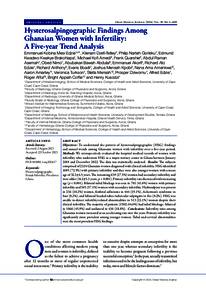Document
Hysterosalpingographic findings among Ghanaian women with infertility : a five-year trend analysis.
Identifier
DOI 10.5001/omj.2024.57
Source
Oman Medical Journal, v. 39, no. 2, e609 p. [1-9].
Contributors
Dzefi-Tettey, Klenam., Author
Gorleku, Philip Narteh., Author
Amedi, Michael Kofi., Author
Quarshie, Frank., Author
Asemah, Abdul Raman., Author
Nimo, Obed., Author
Abdulai, Abubakari Bawah., Author
Akorli, Emmanuel., Author
Edzie, Richard Ato., Author
Anthony, Richard., Author
Boadi, Evans., Author
Kpobi, Joshua Mensah., Author
Amankwa, Nana Ama., Author
Amartey, Aaron., Author
Turkson, Veronica., Author
Mensah, Stella., Author
Dziwornu, Prosper., Author
Edzie, Alfred., Author
Afful, Roger., Author
Coffie, Bright Appiah., Author
Kusodzi, Henry., Author
Country
Oman
City
Muscat
Publisher
Oman Medical Specialty Board.
Gregorian
2024-03-01
Language
English
English abstract
Objectives: To understand the pattern of hysterosalpingographic (HSG) findings
and annual trends among Ghanaian women with infertility over a five-year period.
Methods: We retrospectively evaluated the hospital medical records of women with
infertility who underwent HSG at a major tertiary center in Ghana between January
2018 and December 2022. The data was statistically analyzed. Results: The subjects
comprised of 2324 Ghanaian women diagnosed with clinical infertility. HSG identified
1685 (72.5%) with primary infertility and they were also younger women with a mean
age of 32.2±4.5 years. The remaining 639 (27.5%) women had secondary infertility and
were older (34.2±5.3 years; p 0.001). Primary infertility rate decreased with increasing
age (p 0.001). Bilateral tubal blockage was seen in 701 (41.6%) women with primary
infertility and 365 (57.1%) women with secondary infertility. Hydrosalpinx was present
in 236 (10.2%) women, fimbrial adhesions in 444 (19.1%), Asherman’s syndrome in
four (0.2%), and bilateral beaded tubes/tubercular salpingitis in five (0.2%). HSG was
unable to detect infertility-related abnormalities in 513 (22.1%) women despite their
clinical infertility. The majority of patients (1502; 64.6%) had tubal blockage: bilateral
in 1066 (45.9%) and unilateral in 436 (18.8%). Conclusions: Infertility rates among
Ghanaian women increased at an accelerating rate over the years. Primary infertility was
significantly more prevalent among younger women. Tubal and cervical abnormalities
were the most prevalent HSG findings.
ISSN
1999-768X (Print)
2070-5204 (Electronic)
Category
Journal articles

